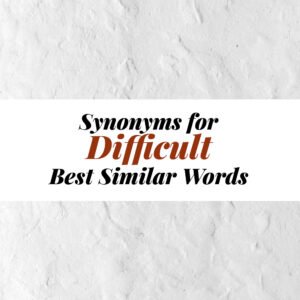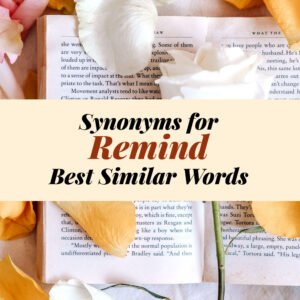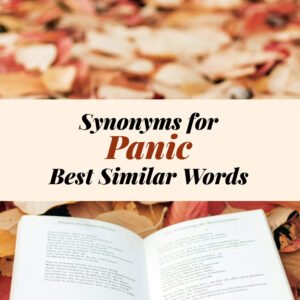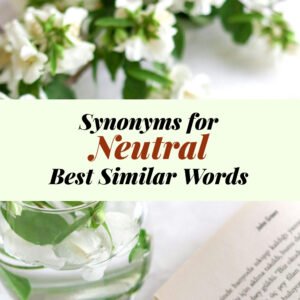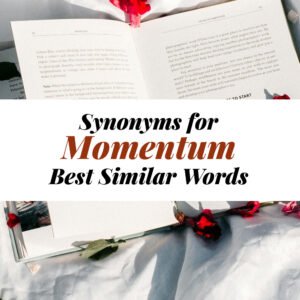Dark is a word we use to describe the absence of light or something that looks shadowy. Sometimes, using the same word again and again can make writing boring. Luckily, there are many other words you can use instead of dark, such as dim, shadowy, gloomy, and murky. These words can make your sentences more interesting and expressive. In this article, we will explore 17 different ways to say dark, along with examples to help you use them correctly.
| Synonym | Meaning | Example |
|---|---|---|
| Dim | Not bright, low light | The room was dim, so I turned on a lamp. |
| Shadowy | Full of shadows or shapes that are hard to see | He walked through a shadowy alley at night. |
| Gloomy | Sad, dark, or depressing | The rainy day made everything look gloomy. |
| Murky | Dark and difficult to see through | The water in the pond was murky and thick. |
| Pitch-black | Completely black, no light | The cave was pitch-black inside. |
| Dusky | Slightly dark, often in the evening | The dusky sky looked beautiful at sunset. |
| Obscure | Not clear, hidden from view | The path was obscure under the thick trees. |
| Tenebrous | Very dark, shadowy, or mysterious | The tenebrous forest gave him a sense of fear. |
| Shady | Covered in shade, not bright | We sat under a shady tree to cool down. |
| Blackened | Made dark, often by fire or dirt | The walls were blackened after the fire. |
| Overcast | Cloudy, not bright | The overcast sky made the day look dull. |
| Somber | Dark in mood or color | She wore a somber dress to the funeral. |
| Dimmed | Made less bright | The lights dimmed as the show began. |
| Clouded | Covered or darkened by clouds or fog | The mountains were clouded in the morning. |
| Murk | Darkness, cloudiness, or gloom | He could not see through the murk of the room. |
| Shadowed | Covered in shadows | The valley was shadowed by tall cliffs. |
| Twilight | The time when the sun is just below the horizon | We enjoyed a walk during twilight. |
17 Different Ways to Say DARK: Another Word for DARK
Dim
Dim is a word used to describe something that is not bright. It can refer to a room, light, or even a mood. When you say something is dim, you are showing that it has little light, so it might be hard to see clearly. Dim is often used to describe lights that are soft or weak. You can also use dim to talk about your eyes or memory when they are not sharp. Using dim can make your writing feel more descriptive because it gives readers a picture of low light or softness.
- The dim lamp barely lit the room.
- I could see a dim figure in the distance.
- The movie theater was dim, making it cozy.
Shadowy
Shadowy means full of shadows or dark shapes. It is used when something is not easy to see because the light is blocked or shapes make it hard to see clearly. Shadowy can describe a person, a place, or even an idea that is unclear. It is often used in stories to create a feeling of mystery or fear. You can describe streets, forests, or rooms as shadowy to make them feel secret or dangerous. Using shadowy helps your reader imagine dark areas where things hide.
- The shadowy forest scared the children.
- He noticed a shadowy figure behind the wall.
- The alley was shadowy and quiet at night.
Gloomy
Gloomy is used to describe something that is dark in color, mood, or weather. A gloomy place feels sad or depressing. It can also refer to cloudy days when there is little sunlight. Gloomy can describe both feelings and environments. This word is great when you want to show sadness or heaviness. Gloomy makes your writing emotional and helps readers feel the atmosphere of a dull or dark place.
- The rainy day made the garden look gloomy.
- She felt gloomy after hearing the bad news.
- The gloomy room needed a bright light to feel better.
Murky
Murky describes water or air that is dark, thick, and hard to see through. It is often used for places that are not clear and may feel dirty or mysterious. Murky can also describe situations that are confusing or hard to understand. Using murky in writing helps your readers imagine a place that is both dark and unclear. It makes scenes feel mysterious or dangerous.
- The pond water was murky and green.
- He could not see the bottom of the murky river.
- The instructions were murky, so we were confused.
Pitch-black
Pitch-black means completely dark, without any light at all. It is stronger than just dark or dim. You can use pitch-black for night scenes, caves, or rooms where there is no light. It gives a feeling of total darkness, which can be scary or dramatic. Using pitch-black helps your writing show extreme conditions and can make your readers feel like they are in the dark place.
- The cave was pitch-black inside.
- She stumbled in the pitch-black night.
- The room became pitch-black when the lights went out.
Dusky
Dusky is used to describe light that is soft and slightly dark. It is often used for evenings or places that are not completely dark but not bright either. Dusky can describe the sky, skin, or rooms. It gives a sense of warmth and calmness. Using dusky can make your descriptions feel gentle and peaceful, not scary or heavy.
- The dusky sky was beautiful at sunset.
- They walked in the dusky light of the evening.
- Her dusky skin glowed in the soft light.
Obscure
Obscure means not clear or hidden. Something obscure is hard to see, understand, or find. It can describe objects, ideas, or places. Using obscure makes your writing more interesting because it shows that something is mysterious or secret. It helps readers imagine things that are not easy to see.
- The path was obscure under the thick trees.
- The old book contained obscure writings.
- He found an obscure painting in the attic.
Tenebrous
Tenebrous means very dark and shadowy. It is often used to describe a mysterious or frightening place. Tenebrous gives a strong feeling of darkness and can make stories feel spooky or serious. Using tenebrous makes your writing more dramatic and helps readers feel fear or curiosity about the dark place.
- The tenebrous forest gave him a sense of fear.
- The room was tenebrous and silent.
- A tenebrous shadow moved across the wall.
Shady
Shady means covered in shadows or not bright. It can describe trees, streets, or areas where the sun does not reach. Shady can also mean a secretive or suspicious person in other situations. It makes your writing feel protective, cool, or sometimes unsafe. Using shady adds detail to outdoor or light-filled scenes.
- We sat under a shady tree to cool down.
- The shady street was quiet and dark.
- A shady corner of the park provided shade.
Blackened
Blackened means made dark, often by fire, dirt, or damage. It can describe objects, walls, or skin after heat or smoke. Using blackened gives a sense of damage or strong darkness. It makes your writing vivid and dramatic because it shows change caused by an event.
- The walls were blackened after the fire.
- He had blackened hands from the soil.
- The toast was blackened in the oven.
Overcast
Overcast means cloudy and not bright. It is often used to describe the sky when the sun is hidden. Overcast can also affect mood because cloudy skies feel sad or calm. Using overcast gives a realistic description of weather and helps readers imagine a day that is not sunny.
- The overcast sky made the day look dull.
- We planned a picnic, but it was overcast.
- The mountains were overcast and grey.
Somber
Somber means dark in mood or color. It is often used for events or clothing that feel serious or sad. Somber can describe emotions, places, or colors. Using somber helps your writing show respect, sadness, or heaviness. It is perfect for serious scenes.
- She wore a somber dress to the funeral.
- The room had a somber atmosphere.
- His somber face showed his worry.
Dimmed
Dimmed means made less bright. Lights, screens, or eyes can be dimmed. Dimmed shows a reduction in brightness, not complete darkness. Using dimmed helps your writing describe changes in light and creates a gentle or calm effect.
- The lights dimmed as the show began.
- Her eyes dimmed with tiredness.
- The screen dimmed automatically at night.
Clouded
Clouded means covered or darkened by clouds, fog, or emotions. It can describe weather, glass, or feelings. Using clouded helps your writing show mystery, sadness, or unclear views.
- The mountains were clouded in the morning.
- His mind was clouded with doubt.
- The glass was clouded from steam.
Murk
Murk means darkness, cloudiness, or gloom. It is used for places, water, or air that are hard to see through. Murk gives a sense of heaviness or mystery. Using murk makes your writing atmospheric and descriptive.
- He could not see through the murk of the room.
- The river was full of murk.
- Shadows moved in the murk of the night.
Shadowed
Shadowed means covered in shadows. It can describe valleys, rooms, or objects. Shadowed gives a sense of partial darkness and adds depth to writing.
- The valley was shadowed by tall cliffs.
- His face was shadowed by a hat.
- The garden looked shadowed in the evening.
Twilight
Twilight is the time when the sun is just below the horizon. It is not bright and not completely dark. Twilight can describe the sky, mood, or scenes. Using twilight makes writing feel calm and magical.
- We enjoyed a walk during twilight.
- The sky was colored with twilight shades.
- The city looked peaceful in twilight.

Final Thoughts
There are many ways to say dark. Each word adds a unique feeling or picture to your writing. Using these synonyms makes descriptions more interesting and engaging.
